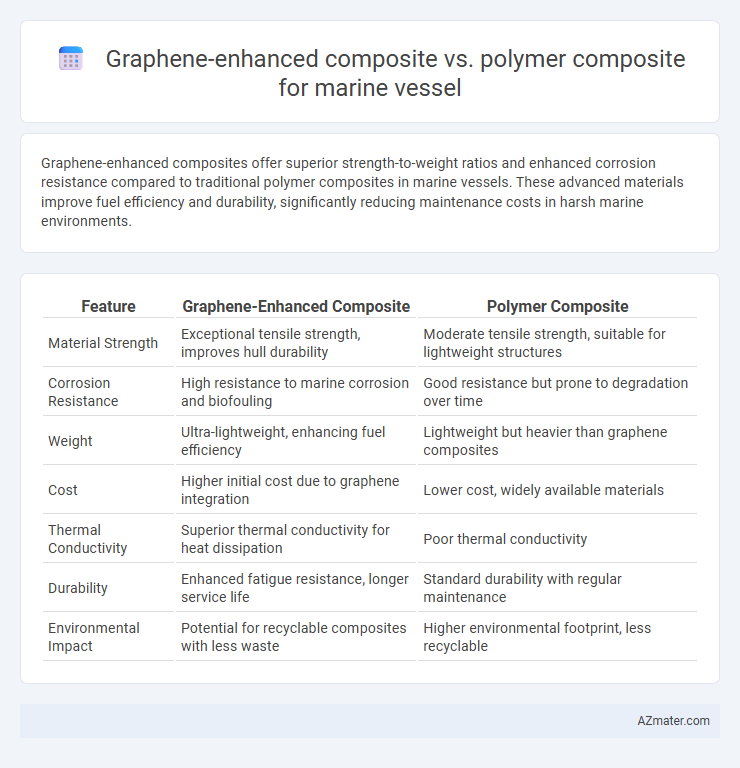Graphene-enhanced composites offer superior strength-to-weight ratios and enhanced corrosion resistance compared to traditional polymer composites in marine vessels. These advanced materials improve fuel efficiency and durability, significantly reducing maintenance costs in harsh marine environments.
Table of Comparison
| Feature | Graphene-Enhanced Composite | Polymer Composite |
|---|---|---|
| Material Strength | Exceptional tensile strength, improves hull durability | Moderate tensile strength, suitable for lightweight structures |
| Corrosion Resistance | High resistance to marine corrosion and biofouling | Good resistance but prone to degradation over time |
| Weight | Ultra-lightweight, enhancing fuel efficiency | Lightweight but heavier than graphene composites |
| Cost | Higher initial cost due to graphene integration | Lower cost, widely available materials |
| Thermal Conductivity | Superior thermal conductivity for heat dissipation | Poor thermal conductivity |
| Durability | Enhanced fatigue resistance, longer service life | Standard durability with regular maintenance |
| Environmental Impact | Potential for recyclable composites with less waste | Higher environmental footprint, less recyclable |
Introduction to Marine Composite Materials
Marine composite materials combine fibers and resins to deliver lightweight, corrosion-resistant solutions essential for vessel durability and performance. Graphene-enhanced composites incorporate graphene nanosheets, significantly improving mechanical strength, stiffness, and electrical conductivity compared to traditional polymer composites. These advanced composites reduce maintenance costs and enhance fuel efficiency by providing superior resistance to marine environmental factors such as saltwater corrosion and biofouling.
Overview of Polymer Composites in Marine Applications
Polymer composites in marine applications offer exceptional corrosion resistance, lightweight properties, and high strength-to-weight ratios, making them ideal for hulls, decks, and structural components in vessels. These composites typically combine fiberglass or carbon fibers with resin matrices like epoxy or polyester, enhancing durability and reducing maintenance costs in harsh marine environments. Compared to traditional materials, polymer composites provide improved fuel efficiency and longer service life, essential for sustainable and cost-effective maritime operations.
Graphene-Enhanced Composites: A New Era
Graphene-enhanced composites offer superior mechanical strength, corrosion resistance, and weight reduction compared to traditional polymer composites, making them ideal for marine vessel applications. The integration of graphene nanosheets significantly improves the composite's tensile strength and durability under harsh marine conditions, enhancing overall vessel performance and longevity. These advanced materials contribute to fuel efficiency and reduced maintenance costs by resisting saltwater corrosion and fatigue better than conventional polymers.
Mechanical Properties Comparison
Graphene-enhanced composites exhibit superior mechanical properties compared to traditional polymer composites, offering increased tensile strength, stiffness, and impact resistance crucial for marine vessels. The incorporation of graphene significantly improves fatigue resistance and corrosion protection, enhancing structural integrity under harsh marine environments. These characteristics result in lighter, more durable hulls, promoting fuel efficiency and extended vessel lifespan.
Resistance to Corrosion and Marine Degradation
Graphene-enhanced composites exhibit superior resistance to corrosion and marine degradation compared to traditional polymer composites, thanks to graphene's exceptional impermeability and chemical stability. The incorporation of graphene improves barrier properties, significantly reducing water uptake and preventing the ingress of corrosive salts, thereby enhancing the lifespan of marine vessels. Polymer composites typically suffer from higher rates of degradation due to their lower resistance to seawater exposure, leading to more frequent maintenance and shorter service intervals.
Weight Reduction and Structural Efficiency
Graphene-enhanced composites offer superior weight reduction compared to traditional polymer composites due to graphene's exceptional strength-to-weight ratio, enabling lighter marine vessel structures without compromising durability. The enhanced mechanical properties of graphene facilitate increased structural efficiency, improving resistance to corrosion, fatigue, and impact in harsh marine environments. This results in enhanced fuel efficiency and payload capacity, making graphene composites a transformative material for next-generation marine vessel design.
Manufacturing and Processing Techniques
Graphene-enhanced composites in marine vessels utilize advanced manufacturing techniques such as vacuum-assisted resin transfer molding (VARTM) and automated fiber placement (AFP), which improve dispersion and alignment of graphene within the polymer matrix, resulting in superior mechanical strength and corrosion resistance. Polymer composites typically rely on traditional hand lay-up or resin infusion methods, which may offer simpler processing but often lack the enhanced thermal and electrical conductivity provided by graphene additives. Integration of graphene requires controlled processing parameters to prevent agglomeration, ensuring consistent quality and performance in harsh marine environments.
Cost Implications and Economic Feasibility
Graphene-enhanced composites offer superior strength-to-weight ratios and corrosion resistance compared to traditional polymer composites, potentially reducing long-term maintenance costs and fuel consumption in marine vessels. However, the higher initial production costs and limited large-scale manufacturing capabilities of graphene composites present economic feasibility challenges for widespread adoption. Evaluating total lifecycle costs, including durability and performance benefits, is critical to determining the cost-effectiveness of graphene-enhanced materials versus conventional polymer composites in marine applications.
Environmental Impact and Sustainability
Graphene-enhanced composites offer significant environmental benefits over traditional polymer composites in marine vessels by reducing material weight and improving fuel efficiency, which lowers greenhouse gas emissions during operation. The enhanced durability and corrosion resistance of graphene composites extend vessel lifespan, decreasing the frequency of repairs and material replacements, thus minimizing waste generation. Sustainable sourcing and the potential for improved recyclability in graphene-based materials further contribute to reducing the ecological footprint of marine vessel construction and maintenance.
Future Trends in Marine Composite Technologies
Graphene-enhanced composites exhibit superior strength-to-weight ratios, corrosion resistance, and thermal conductivity compared to traditional polymer composites, making them highly promising for marine vessel applications. Emerging trends indicate increased adoption of graphene-infused laminates and coatings to enhance hull durability, fuel efficiency, and environmental sustainability. Advances in scalable graphene production techniques and hybrid composite formulations are expected to drive widespread integration in next-generation marine vessels.

Infographic: Graphene-enhanced composite vs Polymer composite for Marine vessel
 azmater.com
azmater.com